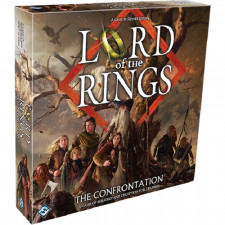Lord of the Rings: The Confrontation Review
on May 24, 2016
“Your quest stands upon the edge of a knife. Stray but a little and it will fail…†Galadriel’s foreboding words resonate throughout Reiner Knizia’s masterful design, Lord of the Rings: The Confrontation. While other, louder and more obnoxious Lord of the Rings games have latched onto the over-the-top battle scenes in Peter Jackson’s recent films, Knizia’s masterpiece by way of contrast stays true to one of the major themes of the books, the desperation and weight of the fellowship’s quest to save the free world.
The Fellowship player does not have to win the battles to win the war. He merely has to stall, deflect, bluff---perhaps occasionally inflicting a loss or two to the Sauron player. These military victories almost always come at a terrible price to the free peoples of Middle-Earth, but they are essential to getting Frodo safely across the mountains to dunk the ring in Mordor. The books’ theme of sacrifice is excellently conveyed as players make the tough decision to throw Sam or Boromir or Merry into a fight they can’t possibly win. Anything to push Frodo one step closer to his fiery destination is a worthwhile exchange.

The Shadow player is at odds with himself as he attempts to catch the elusive Frodo while simultaneously restraining his eager forces, preventing them from overcommitting on the wrong side of the battlefield while the Ring-bearer slips through his fingers. His hidden pieces are much stronger than the free peoples’ forces, and a cursory glance at the combat values and cards would make you think the game is wildly unbalanced. But the good guys’ much more technical and slippery abilities make the game more than a fair fight.
The game is at its strongest when two players face off again and again, echoes of previous matchups informing the bluffing and double-think of the current match. “Did she put the Balrog in Moria again, or does she just want me to think that?†It’s a solid design on its own, but with repeated play between the same opponents, its masterpiece status becomes clear.

The one complaint I can levy at FFG’s recent edition is that the character abilities are not printed on the units themselves. Some previous versions had this feature, and it was much easier to teach and retain that crucial information during play with that implementation. In this one, you have separate play aids and cards for reference. It’s still playable and will become second nature after a few plays, but once too often did I mistake the various Hobbits for one another. Their too-similar art and tiny piece size does not help the situation.
But these are minor complaints. Overall, the art and production design on this version of Knizia’s classic are top-notch. Also included are variant cards and variant units players can use or draft from for a unique game every time, though I think this feature is unnecessary. Knizia’s original design is perfect, so even sticking with the “classic†mode of play is enough for years and years of excellent two-player matchups in the world of Middle-Earth.

 Customer Support
Customer Support  Subscribe
Subscribe 




 Account
Account  Wishlist
Wishlist 

